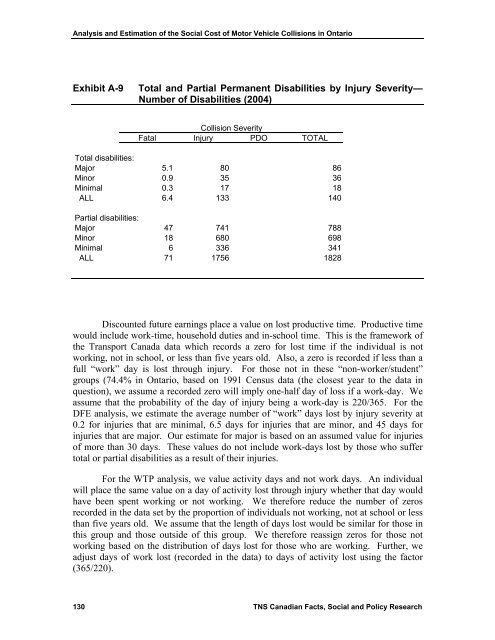Keith Vodden Dr. Douglas Smith - Transports Canada
Keith Vodden Dr. Douglas Smith - Transports Canada
Keith Vodden Dr. Douglas Smith - Transports Canada
Create successful ePaper yourself
Turn your PDF publications into a flip-book with our unique Google optimized e-Paper software.
Analysis and Estimation of the Social Cost of Motor Vehicle Collisions in Ontario<br />
Exhibit A-9<br />
Total and Partial Permanent Disabilities by Injury Severity—<br />
Number of Disabilities (2004)<br />
Collision Severity<br />
Fatal Injury PDO TOTAL<br />
Total disabilities:<br />
Major 5.1 80 86<br />
Minor 0.9 35 36<br />
Minimal 0.3 17 18<br />
ALL 6.4 133 140<br />
Partial disabilities:<br />
Major 47 741 788<br />
Minor 18 680 698<br />
Minimal 6 336 341<br />
ALL 71 1756 1828<br />
Discounted future earnings place a value on lost productive time. Productive time<br />
would include work-time, household duties and in-school time. This is the framework of<br />
the Transport <strong>Canada</strong> data which records a zero for lost time if the individual is not<br />
working, not in school, or less than five years old. Also, a zero is recorded if less than a<br />
full “work” day is lost through injury. For those not in these “non-worker/student”<br />
groups (74.4% in Ontario, based on 1991 Census data (the closest year to the data in<br />
question), we assume a recorded zero will imply one-half day of loss if a work-day. We<br />
assume that the probability of the day of injury being a work-day is 220/365. For the<br />
DFE analysis, we estimate the average number of “work” days lost by injury severity at<br />
0.2 for injuries that are minimal, 6.5 days for injuries that are minor, and 45 days for<br />
injuries that are major. Our estimate for major is based on an assumed value for injuries<br />
of more than 30 days. These values do not include work-days lost by those who suffer<br />
total or partial disabilities as a result of their injuries.<br />
For the WTP analysis, we value activity days and not work days. An individual<br />
will place the same value on a day of activity lost through injury whether that day would<br />
have been spent working or not working. We therefore reduce the number of zeros<br />
recorded in the data set by the proportion of individuals not working, not at school or less<br />
than five years old. We assume that the length of days lost would be similar for those in<br />
this group and those outside of this group. We therefore reassign zeros for those not<br />
working based on the distribution of days lost for those who are working. Further, we<br />
adjust days of work lost (recorded in the data) to days of activity lost using the factor<br />
(365/220).<br />
130 TNS Canadian Facts, Social and Policy Research
















